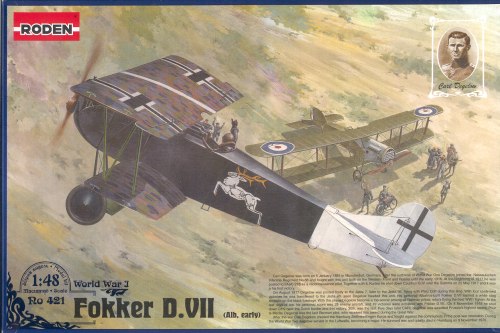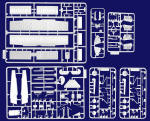
| KIT: | Roden 1/48 Fokker D.VII (Alb - early) |
| KIT #: | 421 |
| PRICE: | $16.98 (15.96 at Squadron) |
| DECALS: | Four options |
| REVIEWER: | Scott Van Aken |
| NOTES: |

| HISTORY |
| THE KIT |
 Roden
definitely knows how to get the most out of its molds. The Fokker D.VII is
a prime example of this. The D.VII was built by several different companies
during its rather short production life. When you add that to the
variations between early and late airframes, you have several different
boxings. This brings about two things. One is that there are a lot of
rather small parts as bits of the airframe are molded separately to take
care of the differences. The other is that the modeler is given the most
accurate representation of that variant possible rather than to have to
make alterations to an existing airframe to incorporate the changes.
Roden
definitely knows how to get the most out of its molds. The Fokker D.VII is
a prime example of this. The D.VII was built by several different companies
during its rather short production life. When you add that to the
variations between early and late airframes, you have several different
boxings. This brings about two things. One is that there are a lot of
rather small parts as bits of the airframe are molded separately to take
care of the differences. The other is that the modeler is given the most
accurate representation of that variant possible rather than to have to
make alterations to an existing airframe to incorporate the changes.
This particular version is for those early D.VIIs produced by Albatross. Now you are probably looking at the image of the parts and wondering just what is different from the previous boxings. Roden has incorporated multiple bits on the standard sprues and as you can see, there are two engines, two exhaust, three props, three wheels, three gear spreader bars in those sprues. What is different amongst the kits is the top center sprue that has the forward engine panels and radiator. This is what allows the builder to do the variant that is boxed.
As with all of Roden's kits, this one is well detailed with very fine parts that need care to remove from the sprues. The parts in this kit are very clean with no flash, no obvious sink areas and only a few ejector towers to remove. The instructions are quite good providing color information in generic terms and Humbrol color references. Markings are provided for four very colorful aircraft. These are:

Fokker D.VII (Alb) early, w/n
unknown, Ltn. R.F. Jakobs, Jasta 43, mid 1918.
Fokker D.VII (Alb) early, w/n unknown, flown by Ltn. August Hartmann, Jasta
30, July 1918.
Fokker D.VII (Alb) early, Jasta 43, pilot unknown, July 1918.
Fokker D.VII (Alb) early, w/n unknown, Ltn. Carl Degelow, Jasta 40, CO, mid
1918.
The decals are well printed and I've heard that they have improved over the last year, which would be great as my previous experience with them was less than positive.
| CONCLUSIONS |
Once more a most welcome addition to the Fokker D.VII ranks and a kit that I'm sure will sell well. This is especially true as the retail price seems to have dropped several dollars, something that will make it even more desirable and an excellent return for the money. If you are used to modern multi-variant kits and want to try your hand at a WWI aircraft, this one would be a good choice.
| REFERENCES |
Roden Web site www.rodenplant.com
You can find this kit and many others at

If you would like your product reviewed fairly and fairly quickly by a site that has nearly 300,000 visitors a month, please contact me or see other details in the Note to Contributors.